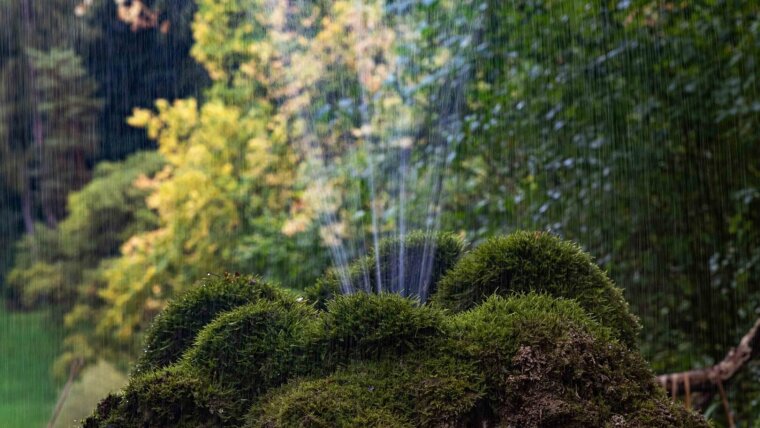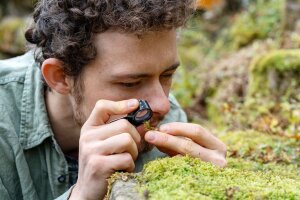
Published: | By: Sebastian Hollstein
PhD student Till Deilmann looks at mosses in the Botanic Garden through a magnifying glass.
Image: Nicole Nerger/Universität JenaWhether on forest floors, in bogs, in the joints of pavements or even in inhospitable regions such as Antarctica – mosses grow almost everywhere. But as ubiquitous as these plants are on earth, in the current research landscape you have to search long and hard for them. Scientific studies of mosses are at best a niche topic. A group of young biologists now wants to change this: On the initiative of PhD student Till Deilmann from Friedrich Schiller University Jena, they are calling for more attention to be paid to this neglected group of plants in an article in the current research magazine "Basic and Applied Ecology".
With more than 20,000 species, mosses are the second largest group of all land plants. They are widespread and found on all continents. For the corresponding ecosystems, they fulfil a number of important functions: "They are an elementary component of the nutrient cycle and the water cycle, regulate the temperature of the soil and thus have an enormous influence on the microbes living there, their living conditions and the entire ecosystem," explains Till Deilmann. "They also act as CO2 reservoirs."
Despite this key role, "mosses are often overlooked and underrepresented in ecological research", write the six researchers from Denmark, Germany and Scotland. "As early career scientists conducting research focussed on mosses, we want to work to raise the profile of this important group by highlighting the obstacles, but also possible solutions on how we can overcome them as an ecological community."
More funding for mosses
The appeal is aimed at a wide range of people. "On the one hand, we want to sensitize research institutions to focus more on mosses in their research, support corresponding projects, initiate networks and collect and make more data available. For example, the question of how mosses react to environmental changes and what consequences this has for their function in the ecosystem and thus ultimately for the ecosystem itself needs to be investigated much more closely," says the Jena scientist, who is working intensively on mosses as part of his doctoral thesis in the Jena Collaborative Research Centre "AquaDiva".
Although these plants are very tolerant survivalists that can live under extreme conditions, they are also very dependent on their immediate environment. For example, unlike other plants, they mainly absorb water and nutrients directly through diffusion via their leaves. If something changes, this has an immediate effect. These properties make them good bioindicators, as they allow researchers to quickly recognize heavy metal contamination, air pollution or changes in the climate.
Because such research work must be financially secure, the young biologists are calling for funding institutions to pay more attention to this field of research, for example through targeted calls for proposals. In addition, research journals should give more space to results on mosses.
Mosses in the textbooks!
More interest in research could ultimately lead to the general public becoming more aware of the importance of mosses – another ojective of the group. "Although they are so ubiquitous, information about mosses, for example, can hardly be found in current school textbooks," says Till Deilmann. The extremely diverse and influential group of plants could also be an exciting topic for the media, museums and other institutions that specialize in knowledge transfer – not least because preserving biodiversity is also important here.
Germany's only professorship for mosses in Jena
Incidentally, Jena is leading by example: the Senckenberg Institute for Plant Form and Function will soon fill the new Professorship of Bryophyte Ecology and Evolution – the only professorship in Germany specifically dedicated to this group of plants. Till Deilmann expects this to bring herbarium specimens, of which there are many in the Herbarium Haussknecht in Jena, back into the focus of current research. "Thanks to them, we can, for example, track the development of individual moss species over a longer period of time."
The digitization of these collections also makes such valuable data available to the international research community. And the public also benefits from this: if the information from the digital specimens were fed into identification apps, users could identify mosses and discover the diversity of these inconspicuous but fascinating plants in a whole new way.
Original publication:
T. J. Deilmann, D. M. Christiansen, M. García Criado, T. Möller, M. Schüle, A. Täuber: "Early Career Researchers advocate for raising the profile of bryophyte ecological research", Basic and Applied Ecology, 2024: DOI : https://doi.org/10.1016/j.baae.2024.11.001External link
